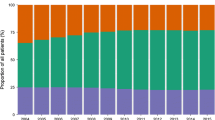Summary
The aim of the DIALA project was to demonstrate the feasibility of structured treatment and teaching programs for type 2 diabetic patients in order to improve the overall quality of care. The investigation was carried out in Upper Austria. The results and findings of structured treatment were evaluated as well as the associated costs of current diabetes management. 19 practitioners were recruited. From the beginning of January 2002 to the end of December 2003, a total of 343 diabetics were registered, and clinical and economic data were collected on all diabetic patients who visited the primary care offices during the period of 24 months. The aims of treatment were discussed between practitioners and patients, routine examinations were carried out quarterly, and all data were recorded using a diabetes care card. All the patients participating in the project were given the opportunity to take part in a diabetes self-management teaching programme. There was an obvious correlation between information and treatment on the one hand and clinical results, as measured by HbA1c, blood pressure levels and body weight on the other. Costs were calculated in a standardized way, and showed a reduction in expense as a result of the structured treatment and cost savings amounting to EUR 620 per annum and patient. The hospital admission rate for cases with diabetes mellitus as the primary diagnosis was considerably reduced. Our results indicate that establishing a structured treatment and teaching programme can improve the quality of diabetes therapy in primary care and influence the rate at which physicians admit patients to hospital.
Zusammenfassung
Mit dem Projekt DIALA – strukturierte Diabetesbetreuung in ländlichen Regionen wurde ein strukturiertes Betreuungs- und Schulungsprogramm für Typ-2-Diabetiker in 5 Bezirken Oberösterreichs eingeführt und in seinen Auswirkungen auf Krankheitsverlauf, Prozessqualität und Kostenentwicklung überprüft. In der Zeit von 1.1.2002 bis 31.12.2003 haben durchgehend 343 Patienten mit Typ-2-Diabetes in 19 allgemeinmedizinischen Praxen teilgenommen. Zwischen Arzt und Patient wurden Behandlungsziele vereinbart, in jedem Quartal Routinekontrollen durchgeführt und im Diabetespass dokumentiert. Allen im Projekt betreuten Diabetikern wurde eine Patientenschulung angeboten. Nach Abschluss des Projektes erfolgte eine Kostenanalyse im Vergleich zu einer Kontrollgruppe. Ein Vergleich der Mittelwerte im ersten Quartal (2002/1) und letzten Quartal (2003/4) der Betreuung zeigt signifikante Veränderungen im HbA1c-Verlauf, bei Blutdruck und Körpergewicht. Insgesamt ergab sich in der Projektgruppe eine Kosteneinsparung von 620 Euro pro Patient und Jahr, die auf eine Verminderung stationärer Aufenthalte zurückzuführen ist. Das Projekt DIALA belegt die Effizienz einer strukturierten Betreuung von Typ-2-Diabetikern in der niedergelassenen Praxis durch hohe Akzeptanz, Verbesserung der Prozessqualität, der klinischen Parameter und der Kostenentwicklung.
Similar content being viewed by others
Author information
Authors and Affiliations
Corresponding author
Rights and permissions
About this article
Cite this article
Ecker, J., Witzmann, G., Gmeiner, H. et al. Structured treatment of diabetes in the country. Wien Med Wochenschr 155, 371–375 (2005). https://doi.org/10.1007/s10354-005-0197-x
Received:
Accepted:
Issue Date:
DOI: https://doi.org/10.1007/s10354-005-0197-x




